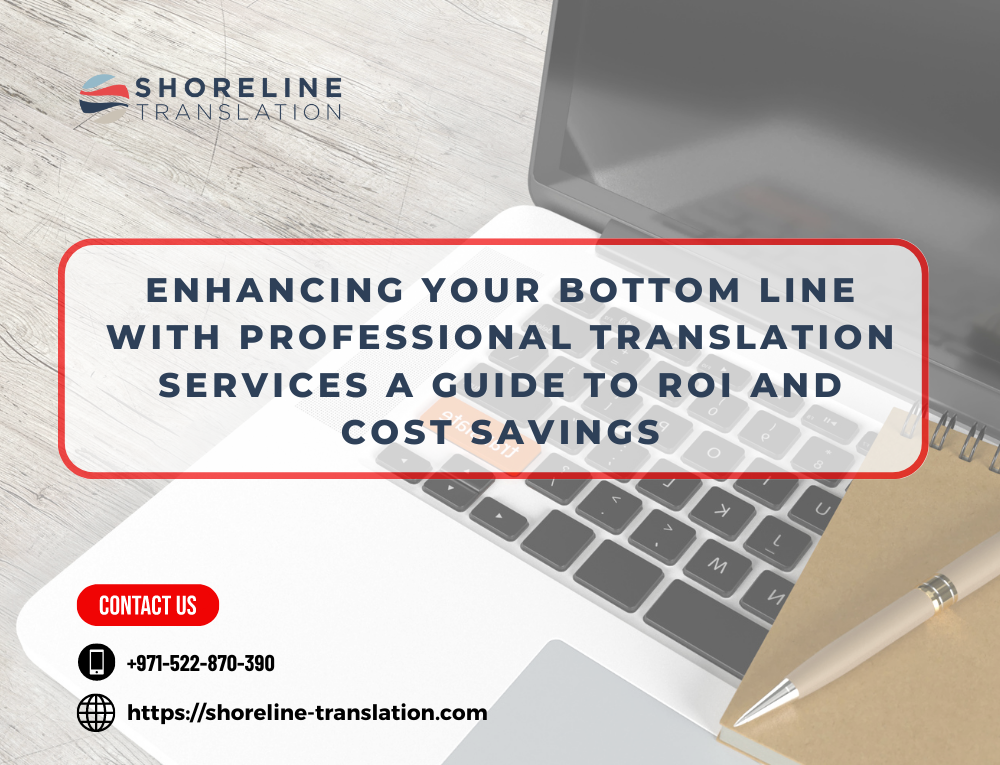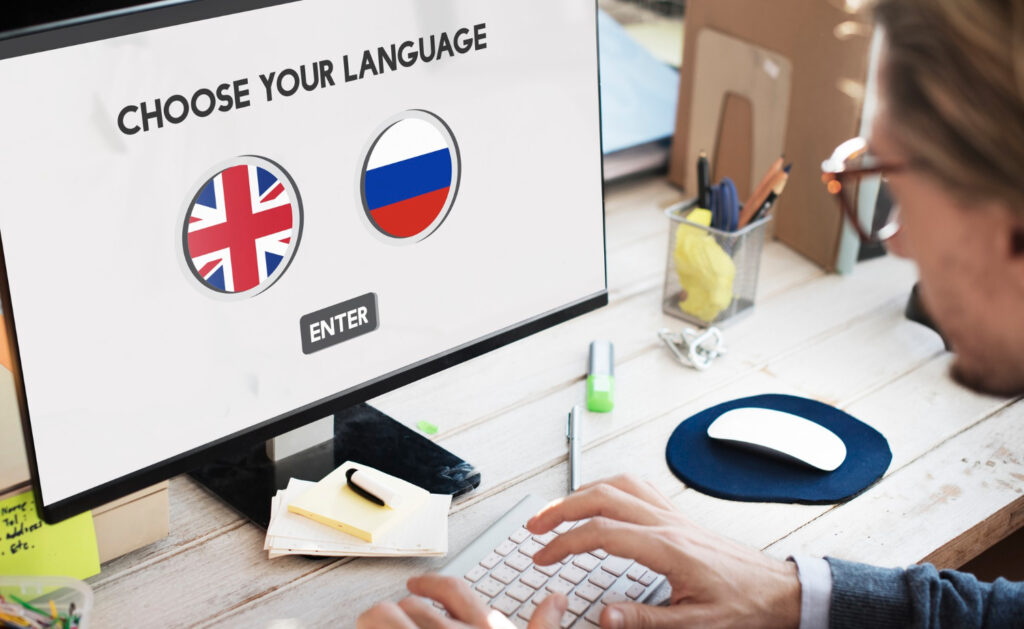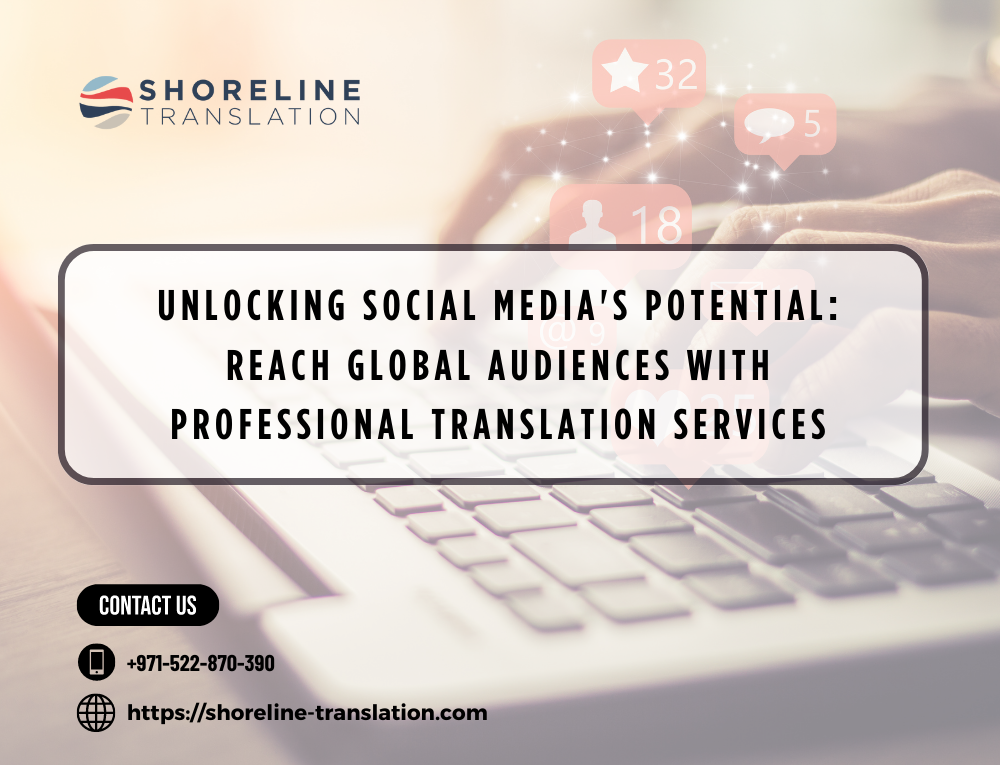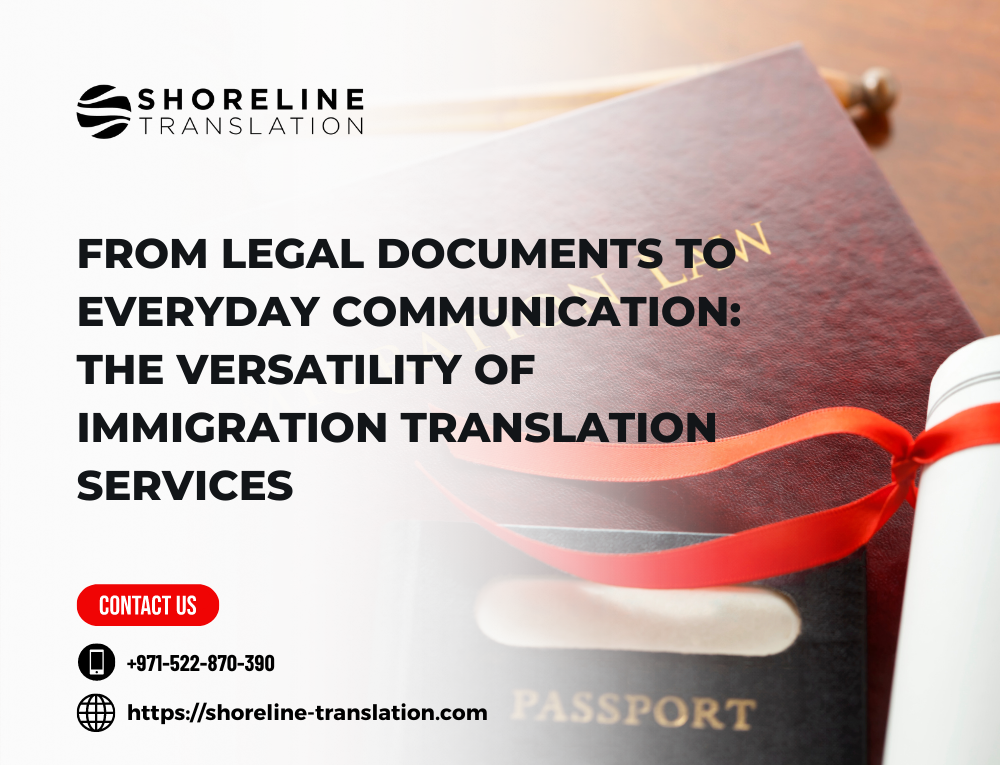Table of Contents
ToggleOverview
In today’s globalized business landscape, effective communication across borders and languages is essential for companies to thrive.
Professional translation services play a vital role in enabling successful international expansion, connecting businesses with diverse markets, and enhancing their bottom line. This blog post aims to provide a comprehensive guide to understanding the return on investment (ROI) and cost savings associated with utilizing professional translation services. By exploring the benefits of accurate translation, leveraging technology, and optimizing processes, organizations can unlock significant growth opportunities while maximizing their financial resources.
In today’s interconnected global marketplace, businesses are constantly seeking ways to expand their reach and connect with diverse audiences. One of the key challenges they face is effective communication across different languages and cultures. This is where professional translation services play a pivotal role, offering expertise and solutions that enhance the bottom line of organizations.

The purpose of this blog post is to provide a comprehensive guide to understanding the return on investment (ROI) and cost savings associated with utilizing professional translation services. By exploring the benefits of accurate translation, leveraging technology, and optimizing processes, businesses can unlock significant growth opportunities while maximizing their financial resources.
Accurate translation serves as the foundation for successful international expansion. It enables companies to tap into new markets, reach untapped customer bases, and increase sales revenue. By conveying their message accurately to potential customers, businesses can establish trust and foster customer loyalty, which is crucial for long-term success. Moreover, accurate translation safeguards a company’s brand reputation. Poorly translated content can lead to embarrassing and offensive mistakes that can undermine a brand’s integrity. By investing in professional translation services, businesses can ensure that their messages are conveyed accurately, aligning with their brand values and resonating with foreign markets.
Additionally, the blog post will delve into how technology can be leveraged to achieve cost savings and improve efficiency. Translation memory, machine translation, computer-assisted translation tools, and translation management systems are all powerful tools that streamline the translation process and reduce costs. Lastly, the post will highlight the importance of optimizing translation processes for maximum ROI. Centralizing translation efforts, developing translation style guides, and establishing strong partnerships with language service providers all contribute to enhancing efficiency and reducing expenses. By exploring these topics, businesses will gain a comprehensive understanding of how professional translation services can enhance their bottom line, increase market reach, and drive sustainable growth in today’s global marketplace.
The Value of Accurate Translation
Translation accuracy is paramount in building trust, maintaining brand consistency, and ensuring effective communication with global audiences.
Professional translation services offer expert linguists with in-depth knowledge of the target language, cultural nuances, and industry-specific terminologies. By investing in accurate translation, businesses can:
- Accurate translation is the cornerstone of effective communication in the global business landscape:
- It goes beyond simply converting words from one language to another; it encompasses a deep understanding of cultural nuances, industry-specific terminology, and the ability to convey messages with precision and clarity.
- The value of accurate translation extends to various aspects of business operations, ultimately contributing to the bottom line in significant ways.
- Expanding market reach is one of the key benefits of accurate translation:
- By effectively translating marketing materials, product descriptions, and communication channels, businesses can tap into new markets and connect with diverse customer bases. This increased accessibility leads to higher visibility, improved brand recognition, and ultimately drives sales and revenue growth.
- Accurate translation also plays a vital role in fostering customer loyalty.
- Offering multilingual customer support and localized content demonstrates a commitment to providing a personalized experience to international customers. Studies have shown that consumers are more likely to purchase products and services in their native language. By meeting the language needs of customers, businesses can build trust, loyalty, and long-term relationships, resulting in repeat business and positive word-of-mouth recommendations.
- Protecting brand reputation is another critical aspect of accurate translation. Poorly translated content can lead to embarrassing or offensive mistakes that can damage a company’s image. In today’s interconnected world, where information spreads rapidly through social media and online platforms, a single translation error can have far-reaching consequences. Investing in professional translation services ensures that messages are accurately conveyed, preserving brand integrity and reputation in foreign markets.
- Furthermore, accurate translation enhances the user experience.
- Whether it’s a website, mobile application, or digital platform, delivering a seamless user experience across languages is crucial.
- Accurate translations help optimize user interfaces, ensuring easy navigation, clear instructions, and engaging content.
- This leads to higher user satisfaction, increased conversion rates, and ultimately, higher revenues.
In summary, accurate translation holds immense value for businesses operating in a globalized world. It enables market expansion, builds customer loyalty, protects brand reputation, and enhances the overall user experience.
By investing in professional translation services, businesses can harness these benefits and ultimately achieve a competitive edge in international markets while driving their bottom line forward.
Expand Market Reach:
Accurate translations enable businesses to reach new markets and tap into previously untapped customer bases. By effectively conveying their message to potential customers, companies can drive sales and revenue growth. Expanding market reach is a key goal for businesses seeking growth and increased profitability. Accurate translation plays a vital role in this process, enabling companies to connect with diverse markets and tap into previously untapped customer bases.
Here are some ways in which accurate translation helps businesses expand their market reach:
Access to New Markets: Accurate translation allows businesses to effectively communicate with customers who speak different languages and reside in different regions. By translating marketing materials, product descriptions, and other business content, companies can break down language barriers and enter new markets. This opens up opportunities to reach a larger audience and increase customer acquisition.
Cultural Relevance: Localization is a crucial aspect of expanding market reach. Accurate translation involves adapting content to suit the cultural context of the target market. It ensures that messages are not only linguistically accurate but also culturally appropriate and resonate with the local audience.
This cultural relevance helps businesses build stronger connections with customers and gain their trust.
Tailored Marketing Strategies: Accurate translation allows businesses to develop targeted marketing strategies for specific regions or language groups.
By understanding the language preferences, cultural nuances, and purchasing behaviors of different markets, companies can tailor their messaging and marketing campaigns accordingly. This customization enhances the effectiveness of marketing efforts and increases the chances of success in new markets.
Increased Visibility and Brand Recognition: Through accurate translation, businesses can improve their visibility in global markets. Translated content helps companies rank higher in local search engine results, making it easier for potential customers to find their products or services. Increased visibility leads to improved brand recognition and awareness, laying the foundation for long-term success in new markets.
Competitive Advantage: Expanding market reach through accurate translation gives businesses a competitive edge. By effectively communicating with international customers in their native language, companies can differentiate themselves from competitors who may not prioritize accurate translation. This advantage allows businesses to establish a strong presence in new markets, attract customers away from competitors, and gain a larger market share.
Foster Customer Loyalty:
Providing multilingual customer support and localized content builds trust and loyalty among international customers. A study by Common Sense Advisory revealed that 75% of consumers prefer to purchase products in their native language, emphasizing the importance of accurate translation for customer satisfaction. Building and nurturing customer loyalty is crucial for the long-term success of any business. Accurate translation plays a significant role in fostering customer loyalty, particularly when it comes to engaging with international customers. Here’s how accurate translation contributes to building loyalty:
Multilingual Customer Support: Providing multilingual customer support demonstrates a commitment to meeting the needs of customers from different language backgrounds. Accurate translation enables effective communication between customer service representatives and international customers, ensuring that their queries and concerns are addressed promptly and accurately. This personalized support fosters trust, satisfaction, and a positive customer experience, leading to increased loyalty.
Localized Content: Accurate translation enables businesses to localize their content for different markets. By adapting marketing materials, product information, and website content to suit the language and cultural preferences of specific regions, companies can connect with customers on a deeper level. Localization shows that businesses understand and respect the unique needs and preferences of their international customers, which builds loyalty and strengthens the customer-brand relationship.
Consistency and Brand Integrity: Accurate translation ensures that brand messages and values remain consistent across different languages. This consistency is crucial for maintaining brand integrity and trust with customers, regardless of their native language. When customers receive consistent messaging that aligns with the brand’s identity and values, it strengthens their connection to the brand and encourages loyalty.
Personalized Communication: Accurate translation allows businesses to communicate with international customers in their native language, creating a sense of familiarity and connection. Personalized communication demonstrates that businesses value their customers and are willing to go the extra mile to meet their language needs. This level of personalization helps businesses build stronger relationships with customers, fostering loyalty and encouraging repeat business.
Protect Brand Reputation:
Poorly translated content can lead to embarrassing or offensive mistakes that damage a company’s brand reputation. Investing in professional translation services ensures that messages are conveyed accurately and align with the brand’s values, protecting its reputation in foreign markets. Brand reputation is a valuable asset for any business, and accurate translation plays a critical role in safeguarding it. Poorly translated content can lead to embarrassing or offensive mistakes that have the potential to damage a company’s image and reputation. Here’s how accurate translation helps protect
Linguistic Accuracy: Accurate translation ensures that messages are conveyed precisely and without errors.
It involves selecting the right words, maintaining proper grammar, and preserving the intended meaning of the content. By investing in professional translation services, businesses can mitigate the risk of mistranslations or misinterpretations that could harm their reputation.
Cultural Sensitivity: Accurate translation goes beyond linguistic accuracy; it also considers cultural nuances and context.
It involves understanding the cultural sensitivities, customs, and norms of the target audience. By adapting content to the cultural context, businesses can avoid cultural missteps or offensive language that could potentially damage their reputation in foreign markets.
Consistent Brand Messaging: Accurate translation ensures that brand messages remain consistent across different languages and regions. Consistency is crucial for maintaining a cohesive brand identity and building trust among customers. When customers encounter consistent messaging that aligns with the brand’s values, it reinforces their perception of the brand and helps protect its reputation.
Quality Assurance: Professional translation services often have quality assurance processes in place to ensure accuracy and reliability. Through rigorous proofreading, editing, and quality checks, these services minimize the risk of errors or inaccuracies in translated content. This attention to detail helps businesses maintain a high standard of quality in their communication, safeguarding their brand reputation.
Enhance User Experience:
Delivering a seamless user experience across languages is crucial for digital platforms, websites, and mobile applications. Professional translation services help optimize user interfaces, ensuring ease of navigation and engagement, which ultimately leads to higher conversion rates and customer satisfaction. A seamless and enjoyable user experience is crucial for engaging customers and driving business growth. Accurate translation contributes significantly to enhancing the user experience, especially in today’s globalized digital landscape. Here’s how accurate translation plays a role in improving user experience:
Clear Communication: Accurate translation ensures that information is effectively communicated to users in their native language. Whether it’s a website, mobile application, or software interface, accurate translations enable users to understand instructions, navigate through menus, and access content without language barriers. This clear communication enhances the user experience by reducing confusion and frustration.
Localization for Cultural Relevance: Accurate translation goes beyond literal conversion; it involves adapting content to suit the cultural context of the target audience. This includes considering cultural nuances, preferences, and localizing user interfaces, graphics, and imagery. By providing a localized user experience, businesses can create a more personalized and relatable environment for users, increasing engagement and satisfaction.
Intuitive Navigation: Accurate translation helps optimize user interfaces and navigation elements to ensure a smooth user experience. Labels, buttons, and menus are translated accurately, enabling users to navigate through digital platforms effortlessly. Intuitive navigation improves usability, reduces friction, and enhances the overall user experience.
Consistency Across Languages: Accurate translation ensures consistency in messaging and branding across different languages. When users encounter a consistent experience across languages, it reinforces the credibility and professionalism of the brand. Consistency in design, tone, and user interface elements helps users feel comfortable and familiar, enhancing their overall experience.
Speed and Efficiency: Accurate translation allows users to access information quickly and efficiently. By providing translated content that is easily accessible and searchable, businesses can cater to the needs of users who prefer to interact in their native language. This speed and efficiency contribute to a positive user experience and encourage users to engage further with the brand.
Leveraging Technology for Cost Savings
In the realm of professional translation services, technology has revolutionized the industry, offering innovative solutions that not only enhance efficiency but also result in substantial cost savings for businesses. Here are some ways in which businesses can leverage technology to achieve cost savings in their translation processes:
Translation Memory: Translation memory is a powerful tool that stores previously translated segments of text for future use.
When a similar or identical sentence or phrase appears in new content, the translation memory system automatically suggests the previously translated segment, saving time and effort. By reusing translations, businesses can reduce translation costs, as they only need to pay for the translation of new or modified content.
Machine Translation: Machine translation (MT) technology has advanced significantly in recent years, offering automated translation solutions. While MT may not provide the same level of accuracy as human translation, it can be leveraged for certain types of content that require a quick understanding or for internal purposes. By utilizing MT, businesses can reduce translation costs, especially for large volumes of content that don’t require extensive human involvement.
Computer-Assisted Translation (CAT) Tools: CAT tools assist human translators in their work by providing features like translation memory integration, terminology management, and quality checks. These tools streamline the translation process, increase productivity, and reduce the time and effort required for translations. By maximizing the efficiency of human translators, businesses can achieve significant cost savings in their translation projects.
Translation Management Systems (TMS): TMS platforms help businesses manage and streamline their translation workflows. These systems provide centralized control, facilitate collaboration among translators and project managers, automate project management tasks, and track translation progress. By using TMS, businesses can optimize their translation processes, eliminate inefficiencies, and reduce administrative costs associated with managing translation projects.
Cloud-Based Solutions: Cloud-based translation platforms offer scalability, flexibility, and cost-effectiveness. These solutions eliminate the need for businesses to invest in and maintain expensive infrastructure or software licenses. Additionally, cloud-based platforms facilitate collaboration and enable remote access, allowing businesses to work with translators located anywhere in the world, further reducing costs. Incorporating technology into the translation process can significantly enhance efficiency and cost savings. Here are some ways businesses can leverage technology when working with professional translation services:
Translation Memory (TM):
TM technology stores previously translated segments, allowing for their reuse in future projects. This reduces translation time and costs while ensuring consistency across various documents and projects. Translation Memory (TM) is a powerful tool used in professional translation services. It functions as a database that stores previously translated segments of text, including sentences, phrases, and paragraphs. When new content is being translated, the TM system automatically searches for matches in the database and suggests the previously translated segments, known as “fuzzy matches” or “exact matches.” Translators can then review and adapt these suggestions to ensure accuracy and context. Translation Memory significantly improves efficiency by reducing the time and effort required for repetitive translations. It not only speeds up the translation process but also ensures consistency across different projects, leading to cost savings for businesses.
Machine Translation (MT):
Automated translation tools, such as machine translation, can be used to handle high-volume content or initial drafts. While MT may lack the accuracy of human translation, it can serve as a cost-effective solution for certain types of content or internal communications. Machine Translation (MT) is an automated translation process that uses computer algorithms to translate text from one language to another. MT systems analyze and process input text, applying linguistic rules, statistical models, or neural networks to generate translations. While MT has improved over time, it still has limitations compared to human translation in terms of accuracy, nuanced understanding, and cultural context. However, MT can be useful for quick and simple translations, especially for internal purposes or to get a general understanding of content.
It can help businesses save costs and time when dealing with large volumes of content that do not require extensive human involvement.
Computer-Assisted Translation (CAT) Tools:
CAT tools assist human translators by providing features like terminology management, glossaries, and quality assurance checks. These tools improve productivity, streamline the translation process, and ultimately reduce costs. Computer-Assisted Translation (CAT) tools are software applications that assist human translators in their work. These tools provide a range of features to enhance translation efficiency and consistency. CAT tools typically include functionalities such as translation memory integration, terminology management, quality assurance checks, and project management capabilities. Translators can leverage these tools to access previously translated segments, ensuring consistency across projects and reducing repetitive work. CAT tools also help streamline the translation process, improve productivity, and maintain accuracy. By leveraging CAT tools, translators can work more efficiently, resulting in cost savings and faster turnaround times for translation projects.
Translation Management Systems (TMS):
TMS platforms offer end-to-end translation project management, from content upload to delivery. They streamline collaboration between translators, project managers, and clients, leading to increased efficiency, faster turnaround times, and reduced administrative overhead. Translation Management Systems (TMS) are software platforms designed to streamline and centralize translation workflows. TMS platforms provide a range of features to facilitate efficient project management, collaboration, and communication between translators, project managers, and clients. These systems allow businesses to manage translation projects, track progress, assign tasks, and maintain version control. TMS platforms often include integrations with other translation tools, such as CAT tools and machine translation systems. By utilizing TMS, businesses can optimize their translation processes, improve project coordination, reduce administrative overhead, and ensure the timely delivery of high-quality translations.
Optimizing Translation Processes for ROI
To maximize return on investment (ROI) in translation services, businesses need to adopt strategies that optimize their translation processes. Here are some key considerations for optimizing translation processes and achieving a higher ROI:
Clear Project Scope: Clearly defining the project scope is essential to avoid scope creep and unnecessary expenses. Establishing the specific goals, target languages, and required deliverables upfront helps streamline the translation process and prevents unnecessary revisions or rework.
Selecting the Right Service Provider: Choosing a reputable and experienced translation service provider is crucial for quality and cost-effectiveness. Look for providers with expertise in your industry and language pairs. Requesting samples, checking client references, and evaluating their technological capabilities can help ensure a reliable and efficient partnership.
Effective Communication: Maintaining open and efficient communication with the translation service provider is essential. Clearly conveying project requirements, providing reference materials, and promptly addressing any questions or clarifications help reduce errors, minimize revisions, and enhance overall productivity.
Translation Technology: Leveraging translation technology, such as Translation Memory (TM) and Computer-Assisted Translation (CAT) tools, improves efficiency, consistency, and cost-effectiveness. These tools facilitate reuse of previously translated content, ensure consistent terminology, and enhance productivity for translators.
Localization and Cultural Adaptation: Tailoring translations to suit the target market’s cultural context increases the effectiveness and impact of the content. Localization involves adapting not only the language but also the imagery, design, and cultural references to resonate with the target audience, fostering better engagement and ROI.
Quality Assurance: Implementing a robust quality assurance process is crucial for maintaining translation accuracy and consistency. This may include proofreading, editing, and thorough review by native speakers to ensure the highest linguistic quality and adherence to project requirements.
By optimizing translation processes through effective project management, selecting the right service provider, leveraging technology, focusing on localization and cultural adaptation, and implementing quality assurance measures, businesses can achieve a higher ROI from their translation investments. Efficient processes lead to improved accuracy, faster turnaround times, reduced costs, and ultimately, better engagement with target markets. To maximize the ROI of professional translation services, organizations should focus on optimizing their translation processes. Here are some key strategies to consider:
Centralize Translation Efforts:
Establishing a centralized translation process, preferably through a dedicated language services provider, improves consistency, ensures quality, and reduces costs associated with multiple vendors or in-house teams. Centralizing translation efforts involves consolidating all translation activities and resources into a centralized system or team. By centralizing translation, businesses can streamline processes, ensure consistency, and optimize resources. It involves establishing a dedicated translation team or partnering with a language service provider to handle all translation projects in a coordinated and efficient manner. Centralizing translation efforts allows for better project management, easier access to translation assets, and improved collaboration. It eliminates redundancies, reduces costs, and enhances overall translation quality. Centralization also enables businesses to maintain control over translation processes and ensure brand consistency across different languages and markets.
Develop Translation Style Guides:
Developing translation style guides is essential for ensuring consistency and maintaining the desired tone, style, and branding in translated content. A translation style guide provides guidelines on various aspects, including vocabulary, grammar, punctuation, formatting, and tone of voice. It helps translators understand the specific requirements and preferences of the business, ensuring a unified approach to translation.
Style guides also aid in maintaining consistent terminology across different translations, enhancing clarity and understanding for the target audience. By developing comprehensive translation style guides, businesses can establish clear guidelines for translators, improve translation quality, and ultimately enhance the effectiveness and impact of their translated content.
In conclusion,
professional translation services offer businesses a multitude of benefits, including enhanced ROI and cost savings. By leveraging accurate translation, businesses can expand their market reach, foster customer loyalty, protect their brand reputation, and enhance the user experience.
Furthermore, technology plays a crucial role in optimizing translation processes, with tools such as Translation Memory (TM), Machine Translation (MT), Computer-Assisted Translation (CAT), and Translation Management Systems (TMS) providing efficiency, consistency, and cost-effectiveness.
To achieve a higher ROI in translation, businesses should prioritize clear project scoping, select the right service providers, facilitate effective communication, leverage translation technology, focus on localization, and implement quality assurance measures. Additionally, centralizing translation efforts and developing translation style guides contribute to consistency and efficiency.
Investing in professional translation services and adopting these strategies not only improves the quality and accuracy of translated content but also delivers tangible business benefits. From reaching new markets to fostering customer loyalty and protecting brand reputation, businesses can capitalize on the power of accurate translation to achieve their goals and drive growth in an increasingly globalized world.





